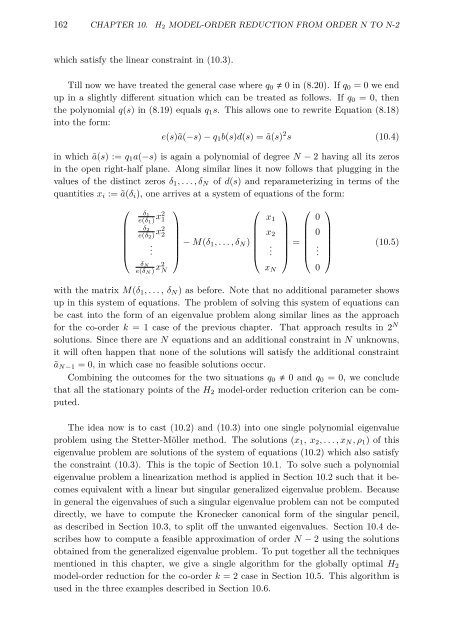link to my thesis
link to my thesis
link to my thesis
You also want an ePaper? Increase the reach of your titles
YUMPU automatically turns print PDFs into web optimized ePapers that Google loves.
162 CHAPTER 10. H 2 MODEL-ORDER REDUCTION FROM ORDER N TO N-2<br />
which satisfy the linear constraint in (10.3).<br />
Till now we have treated the general case where q 0 0 in (8.20). If q 0 = 0 we end<br />
up in a slightly different situation which can be treated as follows. If q 0 = 0, then<br />
the polynomial q(s) in (8.19) equals q 1 s. This allows one <strong>to</strong> rewrite Equation (8.18)<br />
in<strong>to</strong> the form:<br />
e(s)ã(−s) − q 1 b(s)d(s) =ã(s) 2 s (10.4)<br />
in which ã(s) :=q 1 a(−s) is again a polynomial of degree N − 2 having all its zeros<br />
in the open right-half plane. Along similar lines it now follows that plugging in the<br />
values of the distinct zeros δ 1 ,...,δ N of d(s) and reparameterizing in terms of the<br />
quantities x i := ã(δ i ), one arrives at a system of equations of the form:<br />
⎛<br />
δ 1<br />
⎞<br />
⎛ ⎞ ⎛ ⎞<br />
e(δ 1) x2 1<br />
x 1 0<br />
δ 2<br />
e(δ 2) x2 2<br />
x 2<br />
0<br />
⎜<br />
− M(δ ⎝ . ⎟ 1 ,...,δ N )<br />
⎜<br />
=<br />
⎠<br />
⎝ .<br />
⎟ ⎜<br />
(10.5)<br />
⎠ ⎝ .<br />
⎟<br />
⎠<br />
0<br />
δ N<br />
e(δ N ) x2 N<br />
with the matrix M(δ 1 ,..., δ N ) as before. Note that no additional parameter shows<br />
up in this system of equations. The problem of solving this system of equations can<br />
be cast in<strong>to</strong> the form of an eigenvalue problem along similar lines as the approach<br />
for the co-order k = 1 case of the previous chapter. That approach results in 2 N<br />
solutions. Since there are N equations and an additional constraint in N unknowns,<br />
it will often happen that none of the solutions will satisfy the additional constraint<br />
ã N−1 = 0, in which case no feasible solutions occur.<br />
Combining the outcomes for the two situations q 0 0 and q 0 = 0, we conclude<br />
that all the stationary points of the H 2 model-order reduction criterion can be computed.<br />
The idea now is <strong>to</strong> cast (10.2) and (10.3) in<strong>to</strong> one single polynomial eigenvalue<br />
problem using the Stetter-Möller method. The solutions (x 1 ,x 2 ,...,x N ,ρ 1 ) of this<br />
eigenvalue problem are solutions of the system of equations (10.2) which also satisfy<br />
the constraint (10.3). This is the <strong>to</strong>pic of Section 10.1. To solve such a polynomial<br />
eigenvalue problem a linearization method is applied in Section 10.2 such that it becomes<br />
equivalent with a linear but singular generalized eigenvalue problem. Because<br />
in general the eigenvalues of such a singular eigenvalue problem can not be computed<br />
directly, we have <strong>to</strong> compute the Kronecker canonical form of the singular pencil,<br />
as described in Section 10.3, <strong>to</strong> split off the unwanted eigenvalues. Section 10.4 describes<br />
how <strong>to</strong> compute a feasible approximation of order N − 2 using the solutions<br />
obtained from the generalized eigenvalue problem. To put <strong>to</strong>gether all the techniques<br />
mentioned in this chapter, we give a single algorithm for the globally optimal H 2<br />
model-order reduction for the co-order k = 2 case in Section 10.5. This algorithm is<br />
used in the three examples described in Section 10.6.<br />
x N

















